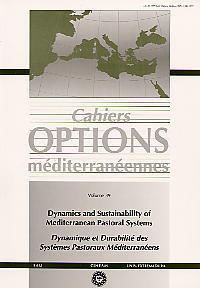| Article précédent | p. 151-155 | Article suivant |
Seasonal growth of forage production in relation to altitude in rangelands of western Crete and its implication to sustained animal production
Forage production of three phryganic rangelands located at the low (25m), middle (675m) and high (1200m) ecological zones respectively of western Crete was studied at the end of each of the four seasons (autumn, winter, spring and summer) of the year. It was found that on the low and middle zones forage production peaked at the end of spring, while on the high zone at the end of summer reaching 378, 534 and 367 g DM per m2 respectively. The bulk of these yields was contributed by the phryganic species (90 per cent) at the first two zones while at the high zone the proportion was much lower (66 per cent) as compared to herbaceous plants. Sarcopoterium spinosum was the dominant species at the low zone, Cistus incanus and C. salviaefolius at the middle zone and Ononis spinosa at the high zone. It was concluded that combining the low and high zones will ensure a 10-month long grazing period for sustained animal production.
- [ Afficher ]
- [ Télécharger ]
- [ Exporter la citation ]
Vous pouvez télécharger la citation au format :
- [ Imprimer ]
-
Mots-clés
ALTITUDE, CROISSANCE, DURABILITE, GRECE, PLANTE FOURRAGERE, PRODUCTIONCiter cet article
Kyriakakis S.D., Papanastasis V.P. Seasonal growth of forage production in relation to altitude in rangelands of western Crete and its implication to sustained animal production. In : Etienne M. (ed.). Dynamics and sustainability of Mediterranean pastoral systems . Zaragoza : CIHEAM, 1999. p. 151-155. (Cahiers Options Méditerranéennes; n. 39). 9. Meeting of the Mediterranean Sub-Network of the FAO-CIHEAM Inter-Regional Cooperative Research and Development Network on Pastures and Fodder Crops, 1997/11/26-29, Badajoz (Spain). http://om.ciheam.org/om/pdf/c39/99600064.pdf



